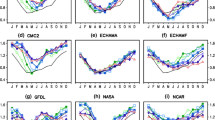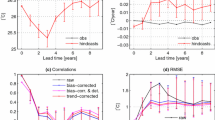Abstract
Based on an intermediate coupled model (ICM), a probabilistic ensemble prediction system (EPS) has been developed. The ensemble Kalman filter (EnKF) data assimilation approach is used for generating the initial ensemble conditions, and a linear, first-order Markov-Chain SST anomaly error model is embedded into the EPS to provide model-error perturbations. In this study, we perform ENSO retrospective forecasts over the 120 year period 1886–2005 using the EPS with 100 ensemble members and with initial conditions obtained by only assimilating historic SST anomaly observations.
By examining the retrospective ensemble forecasts and available observations, the verification results show that the skill of the ensemble mean of the EPS is greater than that of a single deterministic forecast using the same ICM, with a distinct improvement of both the correlation and root mean square (RMS) error between the ensemble-mean hindcast and the deterministic scheme over the 12-month prediction period. The RMS error of the ensemble mean is almost 0.2°C smaller than that of the deterministic forecast at a lead time of 12 months. The probabilistic skill of the EPS is also high with the predicted ensemble following the SST observations well, and the areas under the relative operating characteristic (ROC) curves for three different ENSO states (warm events, cold events, and neutral events) are all above 0.55 out to 12 months lead time.
However, both deterministic and probabilistic prediction skills of the EPS show an interdecadal variation. For the deterministic skill, there is high skill in the late 19th century and in the middle-late 20th century (which includes some artificial skill due to the model training period), and low skill during the period from 1906 to 1961. For probabilistic skill, for the three different ENSO states, there is still a similar interdecadal variation of ENSO probabilistic predictability during the period 1886–2005. There is high skill in the late 19th century from 1886 to 1905, and a decline to a minimum of skill around 1910–50s, beyond which skill rebounds and increases with time until the 2000s.
Similar content being viewed by others
References
Balmaseda, M. A., M. K. Davey, and D. L. T. Anderson, 1995: Decadal and seasonal dependence of ENSO prediction skill. J. Climate, 8, 2705–2715.
Barnston, A. G., M. Glantz, and Y. He, 1999: Predictive skill of statistical and dynamical climate models in SST forecasts during the 1997–98 El Niño and the 1998 La Niña onset. Bull. Amer. Meteor. Soc., 80, 217–243.
Chen, D., M. A. Cane, A. Kaplan, S. E. Zebiak, and D. Huang, 2004: Predictability of El Niño in the past 148 years. Nature, 428, 733–736.
DeWitt, D. G., 2005: Retrospective forecasts of interan nual sea surface temperature anomalies from 1982 to present using a directly coupled atmosphere-ocean general circulation model. Mon. Wea. Rev., 133, 2972–2995.
Efron, B., and R. Tibshirani, 1986: Bootstrap methods for standard errors, confidence intervals, and other measures of statistical accuracy. Statistical Science, 1, 54–77.
Evensen, G., 2003: The ensemble Kalman filter: Theoretical formulation and practical implementation. Ocean Dynamics, 53, 343–367.
Evensen, G., 2004: Sampling strategies and square root analysis schemes for the EnKF. Ocean Dynamics, 54, 539–560.
Goswami, B. N., and J. Shukla, 1991: Predictability of a coupled ocean-atmosphere model. J. Climate, 4, 3–22.
Hamill, T. M., 2001: Interpretation of rank histograms for verifying ensemble forecasts. Mon. Wea. Rev., 129, 550–560.
Kirtman, B. P., and P. S. Schopf, 1998: Decadal variability in ENSO predictability and prediction. J. Climate, 11, 2804–2822.
Kirtman, B. P., 2003: The COLA anomaly coupled model: Ensemble ENSO prediction. Mon. Wea. Rev., 131, 2324–2341.
Keenlyside, N., and R. Kleeman, 2002: On the annual cycle of the zonal currents in the equatorial Pacific. J. Geophys. Res., 107, doi: 10.1029/2000JC0007111.
Latif, M., and Coauthors, 1998: A review of the predictability and prediction of ENSO. J. Geophys. Res., 103, 14,375–14,393.
Mason, S. J., and N. E. Graham, 1999: Conditional probabilities, relative operating characteristics, and relative operating levels. Wea. Forecasting, 14, 713–725.
McCreary, J. P., 1981: A linear stratified ocean model of the equatorial undercurrent. Philosophical Transactions of the Royal Society (London), 298, 603–635.
Moore, A., and Coauthors, 2006: Optimal forcing patterns for coupled models of ENSO. J. Climate, 19, 4683–4699.
Peng, P., and A. Kumar, 2005: A large ensemble analysis of the influence of tropical SSTs on seasonal atmospheric variability. J. Climate, 15, 1068–1085.
Smith, T. M., and R. W. Reynolds, 2004: Improved extended reconstruction of SST (1854–1997). J. Climate, 17, 2466–2477.
Smith, T. M., R. W. Reynolds, T. C. Peterson, and J. Lawrimore, 2008: Improvements to NOAA’s historical merged land-ocean surface temperature analysis (1880–2006). J. Climate, 21, 2283–2296.
Talagrand, O., R. Vautard, and B. Strauss, 1998: Evaluation of probabilistic prediction systems. Proc. Seminar on Predictability, Reading, United Kingdom, ECMWF, 1–26.
Tang, Y., and W. W. Hsieh, 2003: ENSO simulation and predictions using a hybrid coupled model with data assimilation. J. Meteor. Soc. Japan, 81, 1–19.
Tang, Y., Z. Deng, X. Zhou, and Y. Cheng, 2008: Interdecadal variation of ENSO predictability in multiple models. J. Climate, 21, 4811–4833.
Tziperman, E., L. Stone, M. A. Cane, and H. Jarosh, 1994: El Niño chaos: Overlapping of resonances between the seasonal cycle and the Pacific oceanatmosphere oscillator. Science, 264, 72–74.
Zhang, R.-H., S. E. Zebiak, R. Kleeman, and N. Keenlyside, 2003: A new intermediate coupled model for El Niño simulation and prediction. Geophys. Res. Lett., 30(19), 2012, doi: 10.1029/2003GL018010.
Zhang, R.-H., S. E. Zebiak, R. Kleeman, and N. Keenlyside, 2005: Retrospective El Niño forecast using an improved intermediate coupled model. Mon. Wea. Rev., 133, 2777–2802.
Zheng, F., J. Zhu, R.-H. Zhang, and G.-Q. Zhou, 2006a: Ensemble hindcasts of SST anomalies in the tropical Pacific using an intermediate coupled model. Geophys. Res. Lett., 33, L19604, doi:10.1029/2006GL026994.
Zheng, F., J. Zhu, R.-H. Zhang, and G.-Q. Zhou, 2006b: Improved ENSO forecasts by assimilating sea surface temperature observations into an intermediate coupled model. Adv. Atmos. Sci., 23(4), 615–624, doi:10.1007/s00376-006-0615-z.
Zheng, F., 2007: Research on ENSO ensemble predictions. Ph. D. dissertation, Institute of Atmospheric Physics, Chinese Academy of Sciences, 159pp. (in Chinese)
Zheng, F., J. Zhu, and R.-H. Zhang, 2007: Impact of altimetry data on ENSO ensemble initializations and predictions. Geophys. Res. Lett., 34, L13611, doi:10.1029/2007GL030451.
Zheng, F., and J. Zhu, 2008: Balanced multivariate model errors of an intermediate coupled model for ensemble Kalman filter data assimilation. J. Geophys. Res., 113, C07002, doi: 10.1029/2007JC004621.
Zheng, F., H. Wang, and J. Zhu, 2009: Impacts on ENSO ensemble prediction: Initial-error perturbations vs. model-error perturbations. Chinese Science Bulletin. (in press)
Author information
Authors and Affiliations
Corresponding author
Rights and permissions
About this article
Cite this article
Zheng, F., Zhu, J., Wang, H. et al. Ensemble hindcasts of ENSO events over the past 120 years using a large number of ensembles. Adv. Atmos. Sci. 26, 359–372 (2009). https://doi.org/10.1007/s00376-009-0359-7
Received:
Revised:
Published:
Issue Date:
DOI: https://doi.org/10.1007/s00376-009-0359-7




